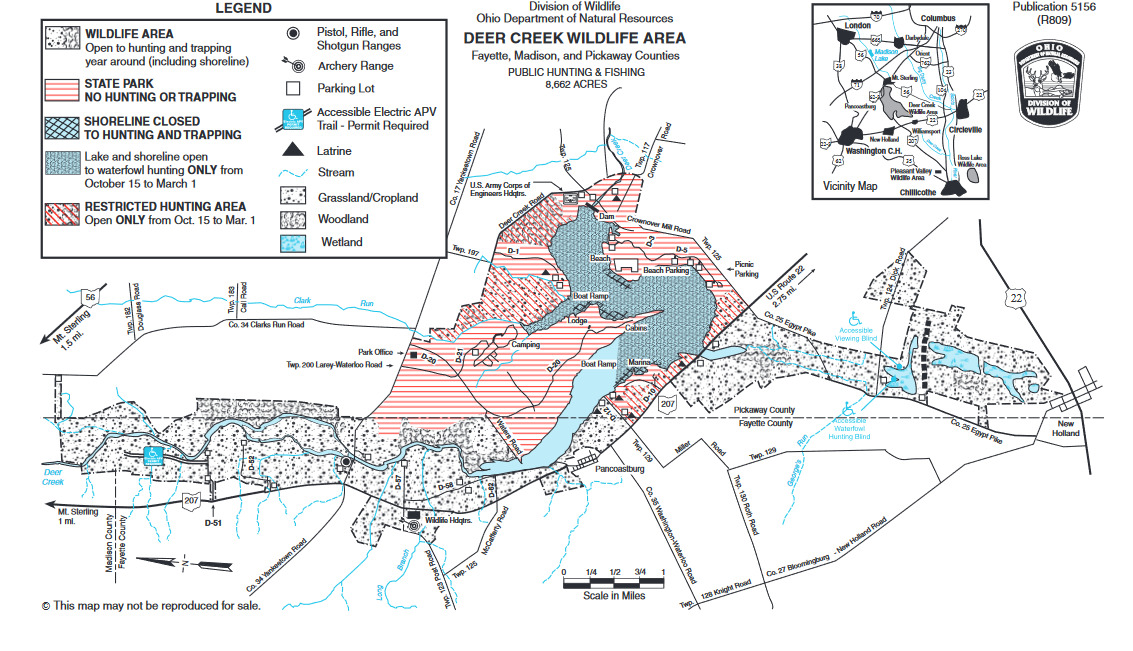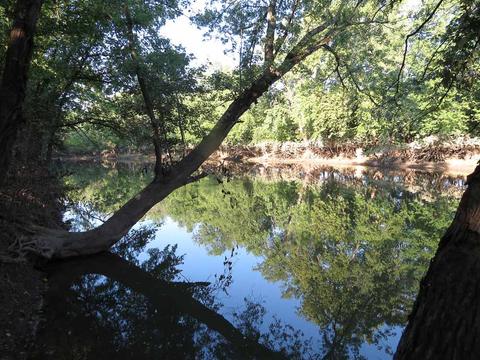
Deer Creek Wildlife Area
Deer Creek Wildlife Area
Mount Sterling, Ohio 43143
Official WebsiteDeer Creek Wildlife Area map
Deer Creek Lake webpage
Deer Creek State Park website
Tips for Birding
The Deer Creek Reservoir and surrounding State Wildlife Area and State Park offer an interesting variety of habitats to explore any time of the year. When the reservoir is drawn down in October (exact dates vary from year to year) is when the area gets the most attention from birders during the fall migration. Because the water levels vary, there can be a rapid turnover in the species present. Fields and woodlands surround the reservoir.
In the southern part of the wildlife area, a wetlands complex on Dick Road offers additional interest. The Deer Creek area is the largest expanse of public land between what was once the Madison Plains and the Pickaway Plains, which is now mostly used for agriculture. These areas were of significance historically, and the Deer Creek area deserves closer scrutiny throughout the year, especially in early spring.
Because of the unusual shape of the reservoir and the varying heights of the water level, the whereabouts of the largest concentration of birds can be unpredictable. Driving along D-58 gives a good view of the upper reaches of the reservoir and is best when the water level is beginning to drop in October. Other vantage points definitely worth checking on the west side, especially later in the fall season, are the end of D-12 (“Miller Park”), and the general Marina area. On the south side of the reservoir, the beach offers a good view, and some of the parking areas along D-5 offer an excellent vantage point to scope out the SW portion of the reservoir. Above the dam wall offers another good vantage point for the SE part of the reservoir. Below the dam wall is a small park where it can be worthwhile to look for birds of riparian woodlands.
North of the reservoir, D-51 and D-52 offer good access into the fields that harbor Dickcissels and Grasshopper Sparrows in the summer, and large numbers of migrant sparrows in the fall. The wooded areas in the state park lands on the east side of the reservoir are most productive for migrant warblers during migration periods. The wetlands south of the reservoir can be explored by parking in any of the several designated locations along Egypt Pike and Dick Roads.
From the North (Columbus) take I-71 south to the Mount Sterling exit (OH-56) and head to Mount Sterling. From Mount Sterling follow the signs to OH-207 and take that south to the western side of the area. From the east (Circleville) take US-22 west to OH-207 or Crownover Road and head north to the area. Washington Court House is less than 10 miles to the southwest.
All areas of interest to birders are open during daylight hours.
Parking areas are numerous in both the state wildlidfe area and state park. Consult map. The large parking area at the beach is usually gated off beginning in November. Park staff currently has no objections to birders parking on the side of the road near the gate during late fall and winter.
Also, see Robert Royse’s Bird Photography Pages
Birds of Interest
Winter
If open water remains, many of the birds noted in the fall can continue into winter. American Tree Sparrows are abundant in the fields and Northern Shrike can occur. Black Vultures can sometimes be seen flying overhead. The wooded peripheries harbor the characteristic Ohio woodland species.
Spring
The upper reaches of the reservoir near Pancoastburg showcase one of the most easily observed Osprey nests in Ohio. The Deer Creek area is currently seldom birded in the spring, but the list of possibilities is long.
Summer
Characteristic nesting birds of Ohio are found in appropriate habitats. Dickcissels can be numerous in the fields during years when they’re present in Ohio.
Fall
Migrant waterfowl, loons, grebes, and gulls may be present in the thousands or relatively scarce, but something interesting always seems to be present. Some of the highlights seen in the reservoir in the fall of 2006 included Laughing Gull, Ross’s Goose, Long-tailed Duck, American White Pelican, and Red-necked Grebe.
In November 1995, a large concentration of 450 Sandhill Cranes used the northern part of the reservoir near Pancoastburg.While this number hasn’t been repeated, Deer Creek remains one of the most reliable places in Ohio to find Sandhill Cranes in the fall, with birds returning to roost in the evenings in small groups. The reservoir is drawn down in October after the main passage of shorebirds through the state, but the later migrating species, especially Killdeer and Dunlin, can occur in sometimes very large numbers. Other shorebirds noted (most annually) include Pectoral, Least, Western, and Baird’s Sandpipers, Greater and Lesser Yellowlegs, Long-billed Dowitchers, and Wilson’s Snipe.
American Pipits can be numerous on the mudflats in the fall, and Snow Bunting has been recorded. In September, 2005 the Dick Road wetlands were kept at a low water level and a pair of American Avocets used the area for nearly a month. In 2006 a Northern Shrike was a fixture near the State Park beach. The wooded areas around the reservoir offer refuge to the full range of migrant passerines such as warblers, vireos, tanagers, and grosbeaks during September and early October. The fields in the wildlife area north of the reservoir can harbor some of the largest numbers of sparrows in the state during migration in October and November. Sunflower fields can congregate other passerines, mainly American Goldfinches, in gigantic flocks. Raptors are conspicuous in the fields of the wildlife area, mostly Northern Harriers and Red-tailed Hawks, but in 2006 Rough-legged Hawk and Golden Eagle were also recorded.
About this Location
The 4,220-acre wildlife area is in central Ohio, four miles south of Mount Sterling on OH-207 and adjacent to the 1,277-acre Deer Creek Lake. It can be reached from the east and west by US-22 and OH-56, and from the north and south by US-62 and OH-3, OH-104, and OH-207.
The topography is flat to slightly rolling. The soils are mostly well drained and of medium to high productivity. Approximately 1,000 acres of row crops and small grains are under cultivation annually. Controlled burning and native warm season grass plantings have also been introduced as part of the wildlife management program.
About 25 percent of the wildlife area consists of second growth hardwoods and brush in advanced stages of succession. The timber stand is mainly on the east side of Deer Creek It includes oak, hickory, elm, black walnut, ash, maple, locust, sycamore, and cottonwood. Index of Ohio’s trees from the Division of Forestry. The uncropped remainder of the area is in permanent meadow, reverting fields, wildlife food plots, and prairie grasses.
Deer Creek Lake construction began in 1965 by the U.S. Army Corps of Engineers for flood control and was completed in 1968. Of the 7,575 acres, 6,875 are leased to the Ohio Department of Natural Resources for fish, wildlife, and general recreation purposes. Deer Creek State Park lies to the south and east of the lake and provides camping, picnicking, and boat launching facilities for the hunter and angler. Public hunting is permitted on some of the undeveloped 3,165 acres controlled by the Division of Parks and Recreation, and on all property controlled by the Division of Wildlife.
Wildlife management plans provide for the maintenance and protection of existing woodlands, establishment of field sizes and crop rotations beneficial to wildlife, improvement of open fields for wildlife nesting, and the establishment of annual food patches for general wildlife use. Permanent wildlife cover has been provided through the planting of native prairie grasses such as switchgrass, big blue stem, and Indiangrass.
Restrooms at Deer Creek State Park.
There is a handicapped accessible bird viewing blind at the Dick Road Wetland.
Content from Official Website and Ohio Ornithological Society

